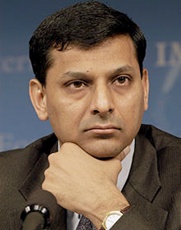RBI keeps policy rates unchanged
01 Apr 2014

This has been done on the basis of the current and evolving macroeconomic situation, RBI said.
Accordingly, RBI kept the policy repo rate under the liquidity adjustment facility (LAF) unchanged at 8.0 per cent and the cash reserve ratio (CRR) of scheduled banks at 4.0 per cent of their net demand and time liabilities (NDTL).
Consequently, the reverse repo rate under the LAF will remain unchanged at 7.0 per cent and the marginal standing facility (MSF) rate and the Bank Rate at 9.0 per cent.
On the other hand, RBI increased the liquidity provided under its 7-day and 14-day term repos from 0.5 per cent of NDTL of the banking system to 0.75 per cent, and decreased the liquidity provided under overnight repos under the LAF from 0.5 per cent of bank-wise NDTL to 0.25 per cent with immediate effect.
Real GDP growth in the country continued to be modest in Q3 of 2013-14, with some strengthening of activity in the service sector such as trade, hotels, transport and communication, and financing, real estate and business services.
Despite some positive movement in more recent data, industrial activity continues to be a drag on the economy, with retrenchment in both consumption and investment demand reflected in the contraction of output of consumer durables as well as capital goods, RBI noted.
In the quarters ahead, the central bank expects the boost provided by robust agricultural production in 2013 to wane.
Moreover, the outlook for the 2014 south-west monsoon appears uncertain. With continued sluggishness in industrial activity, exports and several categories of services, RBI said there is a need to revitalise productivity and competitiveness.
RBI said while consumer price inflation measured by the consumer price index (CPI) moderated for the third month in succession in February 2014, driven lower by the sharp disinflation in most food prices, retail inflation, however, remained sticky at around 8 per cent. This suggests that some demand pressures are still at play.
India's merchandise trade deficit was 22 per cent lower in April-February 2013-14 than its level a year ago, due to the large decline in non-oil imports.
The country's trade deficit has steadily narrowed over the year, shrinking the current account deficit (CAD) to 0.9 per cent of GDP in Q3 of 2013-14. For the year as a whole, the CAD is expected to be about 2.0 per cent of GDP.
However, of late, export growth has slowed, partly because of slowdown in demand in partner countries as well as a softening of prices of exports of petroleum products and gems and jewellery (offset by a reduction in the prices of oil and gold imports), RBI said, adding, whether the export slowdown persists as global growth picks up once again remains to be seen.
Meanwhile, portfolio investments by foreign funds saw a turnaround in February, with an increase in investment flows as investors largely priced in the effects of tapering of the US Fed's quantitative easing.
With sustained inflows in the form of portfolio flows, foreign direct investment (FDI) and external commercial borrowings, external financing conditions turned comfortable. Inflows, augmented by repayments by public sector oil marketing companies of their foreign currency obligations to the Reserve Bank during March, have led to an increase in reserves.
RBI said global economic activity appears to have moderated on slower growth in the US, the UK and Japan, continuing sluggishness in the Euro area and a subdued pick-up in emerging and developing economies, restrained by the uncertain external demand environment as well as by localised cyclical and structural constraints.
For a number of emerging markets, further tightening of external financing conditions and renewed volatility of capital flows are the biggest risks to their outlook. Going forward, global growth is likely to strengthen in the rest of the year, with risks tilted to the downside, it added.
RBI conducted a Rs50,000 crore 21-day term repo, envisaging pressures from large currency demand and tax outflows from mid-March and 7-day term repo auctions of Rs10,000 crore on March 19 and 26, in addition to the regular 14-day term repo of Rs40,000 crore on 21 March.
RBI also conducted a 5-day term repo for a notified amount of Rs20,000 crore on 28 March to facilitate non-disruptive banking operations during the annual closing of accounts.
Access to the MSF on March 29 and 31 (holidays) was also allowed for this purpose.
RBI said it would continue to monitor the liquidity conditions and actively manage liquidity to ensure adequate flow of credit to the productive sectors.
The Reserve Bank's policy stance will be firmly focussed on keeping the economy on a dis-inflationary glide path that is intended to hit 8 per cent CPI inflation by January 2015 and 6 per cent by January 2016.
At the current juncture, it is appropriate to hold the policy rate, while allowing the rate increases undertaken during September 2013-January 2014 to work their way through the economy, RBI said.
Furthermore, if inflation continues along the intended glide path, further policy tightening in the near term is not anticipated at this juncture.
RBI expects the Indian economy to grow at 5 to 6 per cent rate albeit with downside risks to the central estimate of 5.5 per cent. However, RBI said this is contingent on the inflation falling to the desired sliding path and hitting levels below 6 per cent in 2014-15.
In the absence of any lead indicators that point to any sustained revival in industry and services as yet, RBI said, much will depend on the timely arrival and spread of the monsoon, easing of domestic supply bottlenecks and progress on the implementation of stalled projects already cleared.







.webp)














